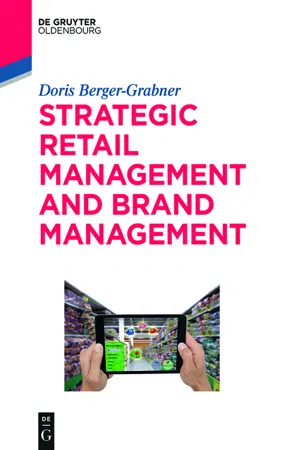
Strategic Retail Management and Brand Management
Trends, Tactics, and Examples
- 456 pages
- English
- ePUB (mobile friendly)
- Available on iOS & Android
About this book
The retail industry and associated business models have gone through a significant phase of disruption. The rapid emergence of new technologies, digital business models and the evolution of social media platforms as a new sales channel continue to influence the sector. Key contextual or external trends will affect and shape the retail landscape in the years to come. Therefore, it seems important to prepare for this situation and be ready with a head start in terms of knowledge.
This textbook provides its readers basic knowledge about the national and international retail sector and gives important insights into trends and developments. It deals with key trends, in particular new patterns of personal consumption, evolving geopolitical dynamics, technological advancements and structural industry shifts. Moreover, it explains why it is so important that retailers use these trends, adapt their retail strategies and tactics, create strong brands and come up with innovative, new ways of doing business.
Today we are living in a challenging time for retail. This textbook tries to give insights and explanations to better understand these challenges and provide managerial implications.
Frequently asked questions
- Essential is ideal for learners and professionals who enjoy exploring a wide range of subjects. Access the Essential Library with 800,000+ trusted titles and best-sellers across business, personal growth, and the humanities. Includes unlimited reading time and Standard Read Aloud voice.
- Complete: Perfect for advanced learners and researchers needing full, unrestricted access. Unlock 1.4M+ books across hundreds of subjects, including academic and specialized titles. The Complete Plan also includes advanced features like Premium Read Aloud and Research Assistant.
Please note we cannot support devices running on iOS 13 and Android 7 or earlier. Learn more about using the app.
Information
Part One: Strategic retail management
- Chapter 1 Strategic Retail Management introduces retailing in general and shows why this field is so essential to be studied. Furthermore, the strategic planning process in retailing will be discussed. In detail, it will be explained how to develop an appropriate retail strategy and how to target different types of consumers. Retail branding and positioning and sustainable retailing, with a special focus on ethical performance in retailing, will also be discussed in Chapter 1.
- Chapter 2 Marketing Mix in Retailing explains the retail marketing mix and refers to the 7Ps in retailing: Product, Price, Place, Promotion, Presentation, People, and Process. There is an emphasis on essential strategic marketing management issues, especially merchandise management, category management, and customer relationship management (CRM).
- Chapter 3 E-Commerce, E-Tailing, and Digitalization looks at trends and developments within the retail sector and defines the most important terms in the digital age. Furthermore, this chapter illustrates innovative technologies and instruments in the retail sector and their challenges and opportunities for retailers and customers.
1 Strategic retail management
1.1 Introduction to retailing
1.1.1 “Wheel of Retailing” and further developments
- emergence and rise
- maturity and assimilation
Table of contents
- Title Page
- Copyright
- Contents
- Part One: Strategic retail management
- Part Two: Brand management
- List of References
- Index